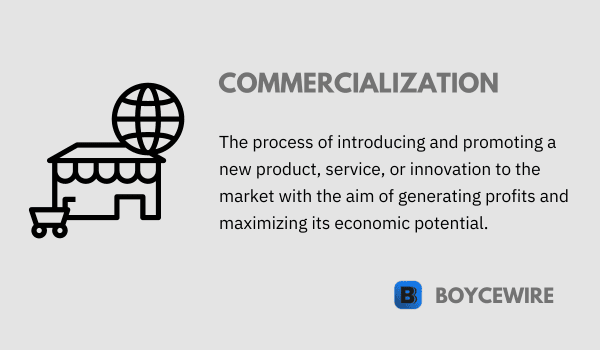Commercialization: Definition, Strategy & Examples

What is Commercialization?
Commercialization is a critical stage in the business cycle, marking the shift from the development of an idea, product, or service to its introduction in the market. In its broadest sense, commercialization refers to the process through which businesses and innovators launch their creations into the public sphere, turning them into commercially viable goods that can generate profit and spur economic growth.
This process involves numerous steps, from initial concept development and feasibility studies to marketing and distribution. In the forthcoming sections, we’ll delve into the deeper aspects of commercialization, explore its benefits and challenges, and consider how technological advancements are shaping its future.
Key Points
- Commercialization is the process of bringing a new product, technology, or innovation to the market with the goal of generating revenue and achieving widespread adoption.
- It involves various steps such as market research, product development, intellectual property protection, branding, marketing, sales, and distribution.
- Successful commercialization can lead to increased revenue, market share, and brand value for businesses.
Understanding Commercialization
Commercialization is a multi-faceted and iterative process that begins once a company has developed a new product or service. It involves preparing the product for the market, scaling up production, establishing marketing and sales channels, and finally, launching the product into the market.
This process hinges on several critical elements, including market research, product development, marketing strategy, sales strategy, and customer support. It is crucial for a company to understand the market and the consumer needs it aims to satisfy before launching its product. This understanding is typically derived from rigorous market research and feasibility studies.
Product development and refinement also play a key role in the commercialization process. It’s essential that the product or service being offered not only meets a particular market need but also surpasses the offerings of competitors in some meaningful way, whether it’s superior quality, innovation, or price.
In terms of marketing and sales strategy, effective commercialization requires clear communication of the product’s benefits to the target market. This typically involves a mix of promotional tactics, from traditional advertising and public relations to digital marketing and social media engagement.
Finally, customer support and after-sales service are crucial to maintaining customer satisfaction and loyalty after the product has been commercialized. This could involve anything from warranty support to maintenance services and can be a key differentiator in the market.
Understanding these various elements and their interplay can significantly enhance a company’s chances of commercializing its products or services successfully.
Steps to Commercialization
- Idea Generation This is the inception point where new product or service ideas are developed. These could come from various sources like employees, customers, market research, competitors, or technological advancements.
- Feasibility Analysis After an idea is generated, it is evaluated for its practicality and profitability. This involves market research to understand consumer needs and preferences, competitor analysis, and financial projections.
- Product Development Once the idea is found to be feasible, it is developed into a physical product or service. This involves detailed planning of product features, specifications, and designing.
- Market Testing The developed product or service is then tested in selective market segments to gather feedback and understand its acceptance level among consumers.
- Product Modification Based on the market testing feedback, necessary modifications are made to the product or service. This could involve changes in design, features, or packaging.
- Manufacturing and Production Planning Post modifications, the product or service goes into full-scale production. This involves planning the production process, sourcing raw materials, and managing the supply chain.
- Marketing and Promotion This involves creating awareness about the product or service among consumers. It includes activities like advertising, public relations, digital marketing, and sales promotions.
- Distribution This involves ensuring the product or service is available to consumers at the right place and at the right time. It requires planning and managing the distribution channels effectively.
- Sales and Customer Support After the product is available in the market, sales activities are carried out to sell the product. Post-sale, customer support is provided to address any issues or concerns raised by the customers.
- Review and Control This is a continuous process where the product’s performance in the market is regularly monitored, and necessary changes are made in the product or marketing strategy based on market feedback.
These steps provide a general framework for commercialization, but the specific process can vary greatly depending on the nature of the product or service, the company, and the market it operates in.
Strategies for Commercialization
- Market Penetration Strategy This strategy involves introducing a new product or service in the current market. Companies use their existing customer base to promote the new product or service and gain acceptance.
- Market Expansion Strategy Here, a company tries to enter a new geographical market with its existing products or services. This is usually done when the current market is saturated or when better opportunities are identified in other markets.
- Product Development Strategy This strategy involves creating a new product or service for an existing market. Companies with strong research and development capabilities often adopt this strategy.
- Diversification Strategy This involves entering a new market with a new product or service. It’s a risky strategy as the company has to deal with unfamiliar market dynamics and consumer behavior while also managing the new product or service.
- Pricing Strategy Pricing plays a crucial role in commercialization. Companies can adopt premium pricing, penetration pricing, economy pricing, or price skimming depending on their product and market condition.
- Collaboration or Partnership Strategy Sometimes, companies collaborate with other businesses to co-develop and co-market a new product or service. This is often done to leverage the strengths of each partner and mitigate risks.
- Licensing and Franchising Strategy For some companies, licensing their technology or franchising their business model to other businesses can be a profitable commercialization strategy. This can rapidly scale a successful product or service, especially in international markets.
- Direct Sales and Online Sales Strategy Depending on the product, companies may use a direct sales force, online sales, or a combination of both. With the growth of e-commerce, many companies are finding online sales to be a cost-effective commercialization strategy.
- Promotion Strategy This could involve a broad range of activities such as advertising, public relations, social media marketing, content marketing, SEO, etc.
It’s important to note that the choice of commercialization strategy should align with the company’s overall business strategy and capabilities, and the dynamics of the market.
Benefits of Commercialization
- Market Expansion Commercialization provides an opportunity for businesses to reach new markets and expand their consumer base. It allows for growth and increased revenue potential.
- Increased Competitiveness When businesses successfully commercialize a product or service, they gain a competitive edge in the marketplace. This could be in the form of unique product features, advanced technology, or innovative service delivery.
- Brand Awareness and Reputation Successful commercialization often leads to increased brand awareness and enhanced corporate reputation. It puts the company’s name out there, helping to attract new customers and potential business partners.
- Job Creation Commercialization often involves scaling up production and marketing efforts, which usually results in the creation of new jobs. This can have positive economic effects on the local community and the economy as a whole.
- Revenue and Profitability The primary goal of commercialization is to generate revenue. If done effectively, it can lead to significant financial gains and increased profitability for a company.
- Innovation Diffusion Commercialization is a critical part of the innovation process. It enables the diffusion of new products, services, or technologies to the wider public, benefiting society by solving problems, improving productivity, and enhancing quality of life.
- Investor Appeal Companies that can successfully commercialize their offerings are often more attractive to investors. It shows the company’s capability not just to innovate, but also to generate returns on those innovations.
Remember, while the process of commercialization can provide these potential benefits, it also involves risk and requires careful planning and execution.
Challenges of Commercialization
- Market Acceptance One of the most significant challenges in commercialization is achieving market acceptance. Businesses must convince consumers that their new product or service meets their needs better than existing options.
- High Costs Commercialization can be expensive. The costs of research and development, production, marketing, and distribution can add up quickly, and there’s no guarantee of a return on this investment.
- Regulatory Hurdles Depending on the product or service, businesses might face regulatory hurdles. These can be time-consuming and expensive to overcome.
- Intellectual Property Rights Protecting intellectual property rights can be challenging but is essential for commercialization. If competitors can easily copy a product, it will be much harder to profit from it.
- Timing Finding the right time to launch a product is crucial. If a product is introduced too early, the market might not be ready for it. If it’s launched too late, it may be overshadowed by competing products.
- Competition The current market competition represents a significant challenge. Competitors with similar products can influence the success of a new product.
- Technological Changes Rapid technological change can either create opportunities for commercialization or make a product obsolete before it even hits the market.
Overcoming these challenges requires strategic planning, effective market research, sound financial management, and sometimes, a bit of luck.
Examples of Commercialization
- Apple’s iPhone Apple’s iPhone is a great example of successful commercialization. It was not the first smartphone, but Apple managed to create a highly user-friendly product and marketed it effectively. The iPhone’s success has made it one of the most iconic products of the 21st century.
- Uber Uber commercialized the concept of a ride-hailing app. They developed an innovative business model where anyone with a car could become a taxi driver, and customers could request a ride from anywhere using their app. They faced and overcame numerous regulatory challenges and have fundamentally changed the taxi industry.
- Netflix Netflix started as a DVD rental service, but they saw the potential of streaming technology early on and pivoted their business model. Today, they’re one of the leading streaming platforms worldwide.
- Impossible Foods and Beyond Meat Both of these companies have successfully commercialized plant-based meat substitutes. They developed innovative products, raised awareness about the environmental impact of meat consumption, and are now sold in supermarkets and restaurants around the world.
- SpaceX SpaceX has commercialized space travel by offering cost-effective solutions to launch satellites and carry cargo and passengers to the International Space Station. They’re planning to offer commercial space travel to Mars in the future.
- 3D Printing Initially, 3D printing technology was expensive and used primarily for prototyping in industrial settings. Today, as the technology has advanced and costs have come down, it’s being commercialized for a wide range of applications, from medical devices to home decor.
Each of these examples represents a case where a company successfully developed a product or service, navigated the challenges of bringing it to market, and realized financial success as a result.
FAQs
Commercialization is the process of taking a new product, technology, or innovation from the development stage and introducing it into the market to generate revenue and achieve widespread adoption.
Commercialization is crucial because it helps transform ideas, research, and inventions into practical applications that can benefit society and generate economic value. It allows businesses and innovators to capitalize on their creations and bring them to market.
The commercialization process typically involves activities such as market research, product development, intellectual property protection, branding, marketing, sales, and distribution. These steps are aimed at effectively launching the product or innovation in the market.
Commercialization provides businesses with the opportunity to generate revenue and profits by leveraging their products or innovations. It allows them to gain a competitive advantage, expand their customer base, create brand value, and establish a strong market presence.
About Paul
Paul Boyce is an economics editor with over 10 years experience in the industry. Currently working as a consultant within the financial services sector, Paul is the CEO and chief editor of BoyceWire. He has written publications for FEE, the Mises Institute, and many others.

Further Reading
 Nominal GDP: Definition & Formula - Nominal GDP is the total economic output of a nation using current prices. In other words, it is the measurement…
Nominal GDP: Definition & Formula - Nominal GDP is the total economic output of a nation using current prices. In other words, it is the measurement…  Determinants of Demand - Determinants of demand are the various factors that influence the quantity of a good or service that consumers are willing…
Determinants of Demand - Determinants of demand are the various factors that influence the quantity of a good or service that consumers are willing…  Socialism vs Capitalism - Socialism is an economic system where the means of production are collectively owned and resources are allocated based on need,…
Socialism vs Capitalism - Socialism is an economic system where the means of production are collectively owned and resources are allocated based on need,… 